Experience Plan for Preschoolers: Family Puppetry and Music Activity
VerifiedAdded on 2022/10/17
|6
|1258
|14
Practical Assignment
AI Summary
This assignment presents a detailed experience plan designed for preschool children aged 4 to 5, centered around family puppetry and music. The activity involves providing children with family puppets and incorporating music to facilitate learning about family relationships, hand-eye coordination, and musical concepts. The plan includes a rationale connecting the activity to observed skills, ensuring it meets the children's capabilities and interests. It aligns with EYLF principles, focusing on building secure relationships and fostering mutual respect. The learning outcomes are specific and measurable, targeting developmental progression in areas such as musical understanding, problem-solving, and communication skills. Teaching strategies include providing clear instructions, offering various puppet sets, showing examples, asking open-ended questions, and providing positive reinforcement. The assignment also provides links to EYLF outcomes and outlines the materials required, such as puppets and musical resources, to effectively implement the activity. References to relevant research are also included.
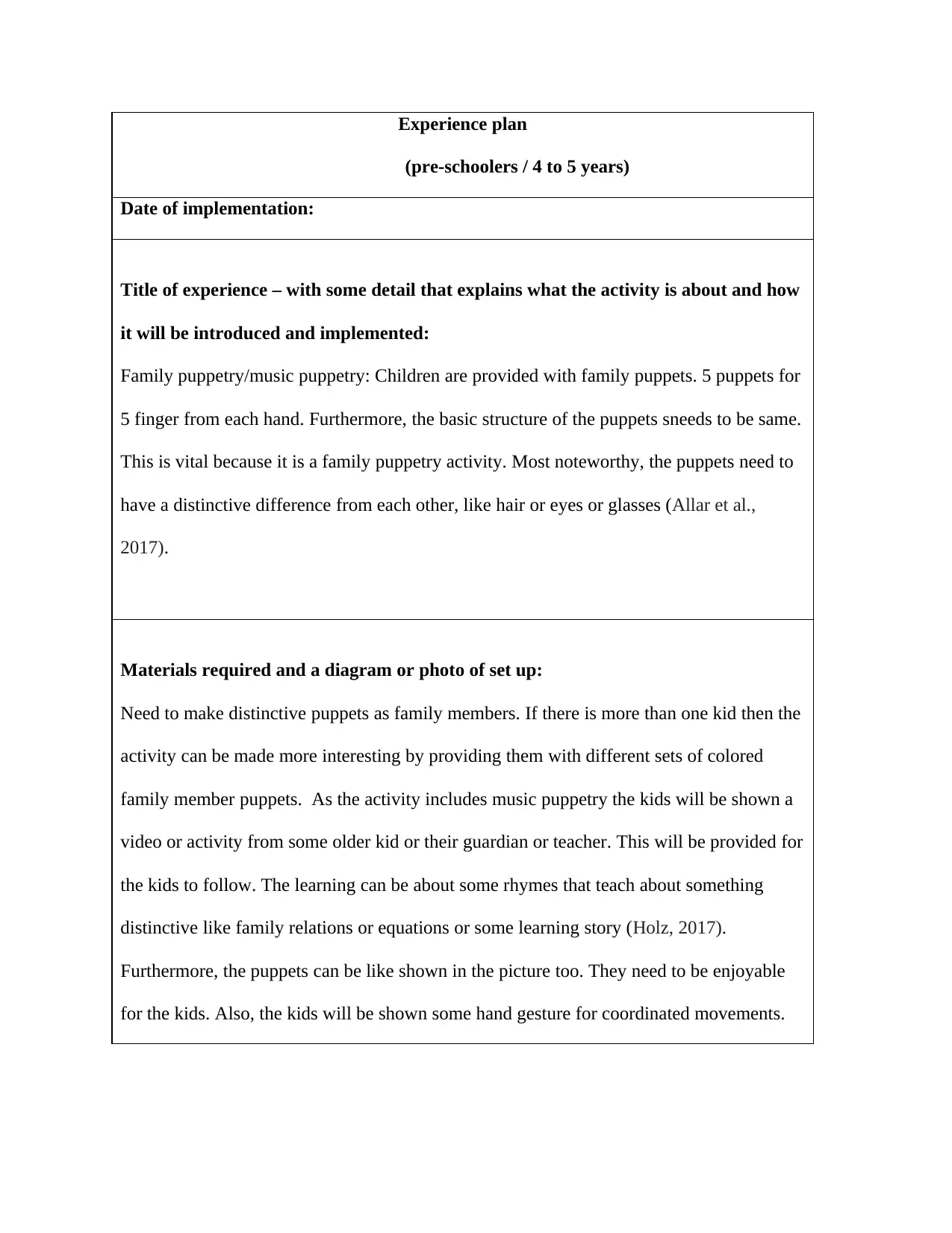
Experience plan
(pre-schoolers / 4 to 5 years)
Date of implementation:
Title of experience – with some detail that explains what the activity is about and how
it will be introduced and implemented:
Family puppetry/music puppetry: Children are provided with family puppets. 5 puppets for
5 finger from each hand. Furthermore, the basic structure of the puppets sneeds to be same.
This is vital because it is a family puppetry activity. Most noteworthy, the puppets need to
have a distinctive difference from each other, like hair or eyes or glasses (Allar et al.,
2017).
Materials required and a diagram or photo of set up:
Need to make distinctive puppets as family members. If there is more than one kid then the
activity can be made more interesting by providing them with different sets of colored
family member puppets. As the activity includes music puppetry the kids will be shown a
video or activity from some older kid or their guardian or teacher. This will be provided for
the kids to follow. The learning can be about some rhymes that teach about something
distinctive like family relations or equations or some learning story (Holz, 2017).
Furthermore, the puppets can be like shown in the picture too. They need to be enjoyable
for the kids. Also, the kids will be shown some hand gesture for coordinated movements.
(pre-schoolers / 4 to 5 years)
Date of implementation:
Title of experience – with some detail that explains what the activity is about and how
it will be introduced and implemented:
Family puppetry/music puppetry: Children are provided with family puppets. 5 puppets for
5 finger from each hand. Furthermore, the basic structure of the puppets sneeds to be same.
This is vital because it is a family puppetry activity. Most noteworthy, the puppets need to
have a distinctive difference from each other, like hair or eyes or glasses (Allar et al.,
2017).
Materials required and a diagram or photo of set up:
Need to make distinctive puppets as family members. If there is more than one kid then the
activity can be made more interesting by providing them with different sets of colored
family member puppets. As the activity includes music puppetry the kids will be shown a
video or activity from some older kid or their guardian or teacher. This will be provided for
the kids to follow. The learning can be about some rhymes that teach about something
distinctive like family relations or equations or some learning story (Holz, 2017).
Furthermore, the puppets can be like shown in the picture too. They need to be enjoyable
for the kids. Also, the kids will be shown some hand gesture for coordinated movements.
Paraphrase This Document
Need a fresh take? Get an instant paraphrase of this document with our AI Paraphraser
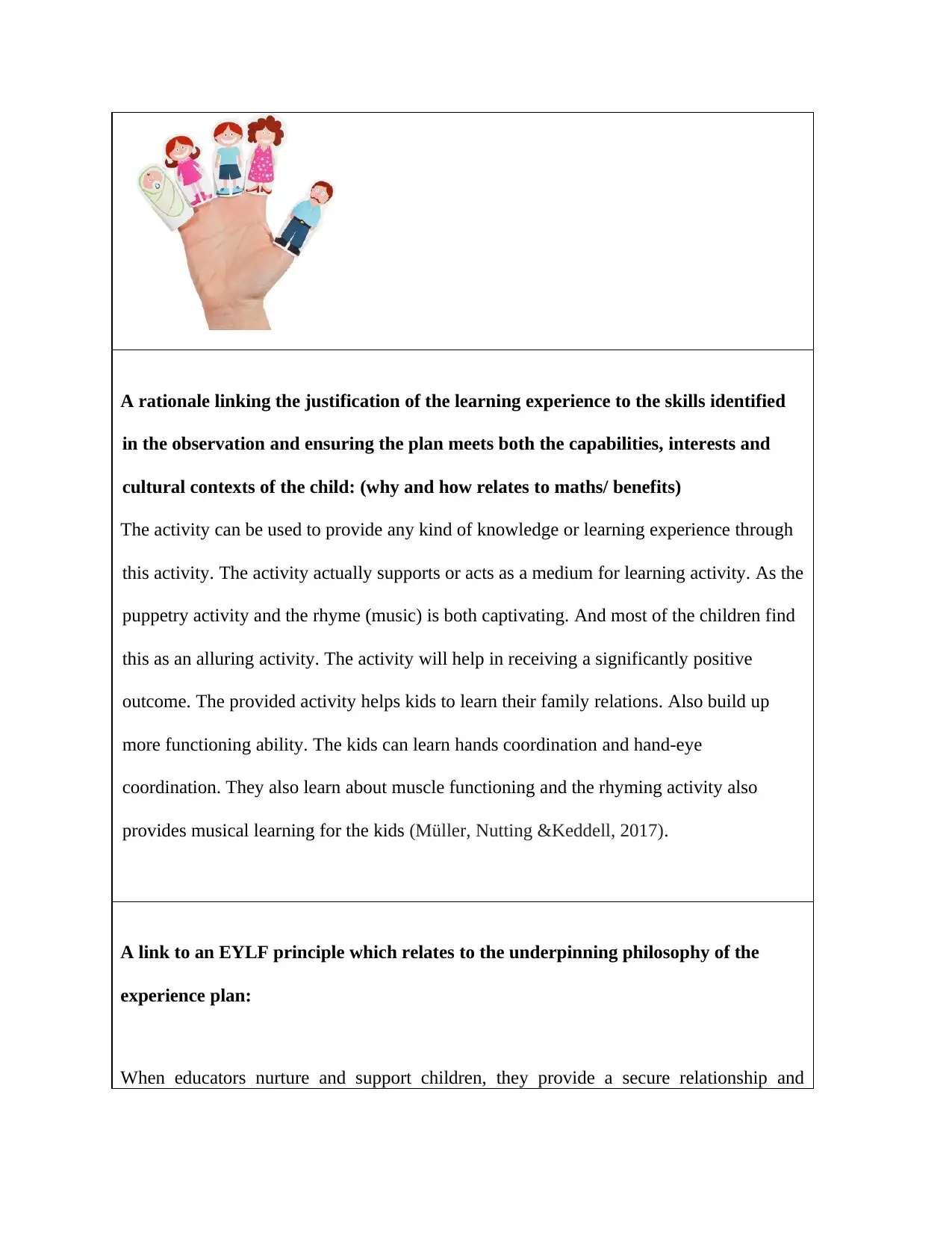
A rationale linking the justification of the learning experience to the skills identified
in the observation and ensuring the plan meets both the capabilities, interests and
cultural contexts of the child: (why and how relates to maths/ benefits)
The activity can be used to provide any kind of knowledge or learning experience through
this activity. The activity actually supports or acts as a medium for learning activity. As the
puppetry activity and the rhyme (music) is both captivating. And most of the children find
this as an alluring activity. The activity will help in receiving a significantly positive
outcome. The provided activity helps kids to learn their family relations. Also build up
more functioning ability. The kids can learn hands coordination and hand-eye
coordination. They also learn about muscle functioning and the rhyming activity also
provides musical learning for the kids (Müller, Nutting &Keddell, 2017).
A link to an EYLF principle which relates to the underpinning philosophy of the
experience plan:
When educators nurture and support children, they provide a secure relationship and
in the observation and ensuring the plan meets both the capabilities, interests and
cultural contexts of the child: (why and how relates to maths/ benefits)
The activity can be used to provide any kind of knowledge or learning experience through
this activity. The activity actually supports or acts as a medium for learning activity. As the
puppetry activity and the rhyme (music) is both captivating. And most of the children find
this as an alluring activity. The activity will help in receiving a significantly positive
outcome. The provided activity helps kids to learn their family relations. Also build up
more functioning ability. The kids can learn hands coordination and hand-eye
coordination. They also learn about muscle functioning and the rhyming activity also
provides musical learning for the kids (Müller, Nutting &Keddell, 2017).
A link to an EYLF principle which relates to the underpinning philosophy of the
experience plan:
When educators nurture and support children, they provide a secure relationship and
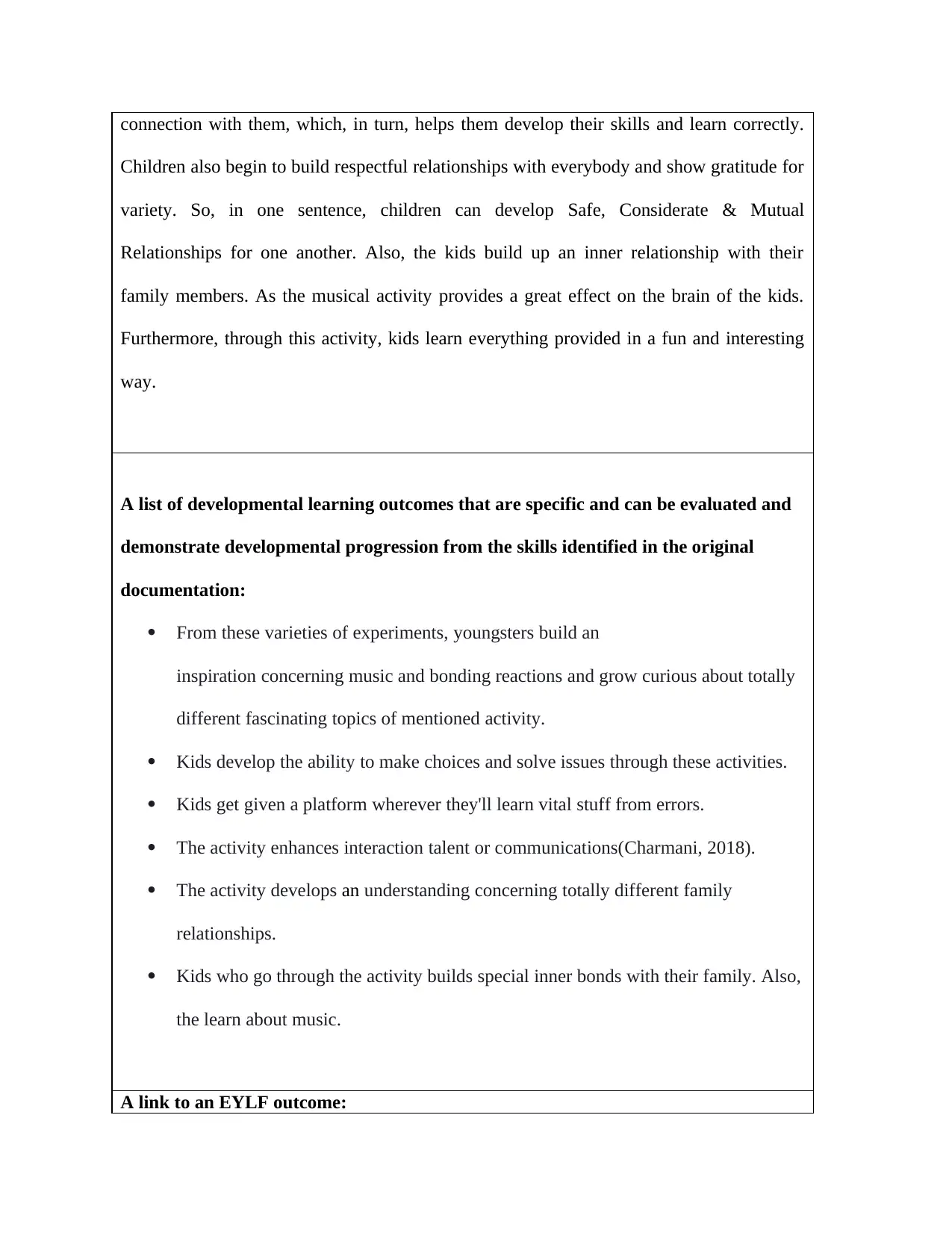
connection with them, which, in turn, helps them develop their skills and learn correctly.
Children also begin to build respectful relationships with everybody and show gratitude for
variety. So, in one sentence, children can develop Safe, Considerate & Mutual
Relationships for one another. Also, the kids build up an inner relationship with their
family members. As the musical activity provides a great effect on the brain of the kids.
Furthermore, through this activity, kids learn everything provided in a fun and interesting
way.
A list of developmental learning outcomes that are specific and can be evaluated and
demonstrate developmental progression from the skills identified in the original
documentation:
From these varieties of experiments, youngsters build an
inspiration concerning music and bonding reactions and grow curious about totally
different fascinating topics of mentioned activity.
Kids develop the ability to make choices and solve issues through these activities.
Kids get given a platform wherever they'll learn vital stuff from errors.
The activity enhances interaction talent or communications(Charmani, 2018).
The activity develops an understanding concerning totally different family
relationships.
Kids who go through the activity builds special inner bonds with their family. Also,
the learn about music.
A link to an EYLF outcome:
Children also begin to build respectful relationships with everybody and show gratitude for
variety. So, in one sentence, children can develop Safe, Considerate & Mutual
Relationships for one another. Also, the kids build up an inner relationship with their
family members. As the musical activity provides a great effect on the brain of the kids.
Furthermore, through this activity, kids learn everything provided in a fun and interesting
way.
A list of developmental learning outcomes that are specific and can be evaluated and
demonstrate developmental progression from the skills identified in the original
documentation:
From these varieties of experiments, youngsters build an
inspiration concerning music and bonding reactions and grow curious about totally
different fascinating topics of mentioned activity.
Kids develop the ability to make choices and solve issues through these activities.
Kids get given a platform wherever they'll learn vital stuff from errors.
The activity enhances interaction talent or communications(Charmani, 2018).
The activity develops an understanding concerning totally different family
relationships.
Kids who go through the activity builds special inner bonds with their family. Also,
the learn about music.
A link to an EYLF outcome:
⊘ This is a preview!⊘
Do you want full access?
Subscribe today to unlock all pages.

Trusted by 1+ million students worldwide
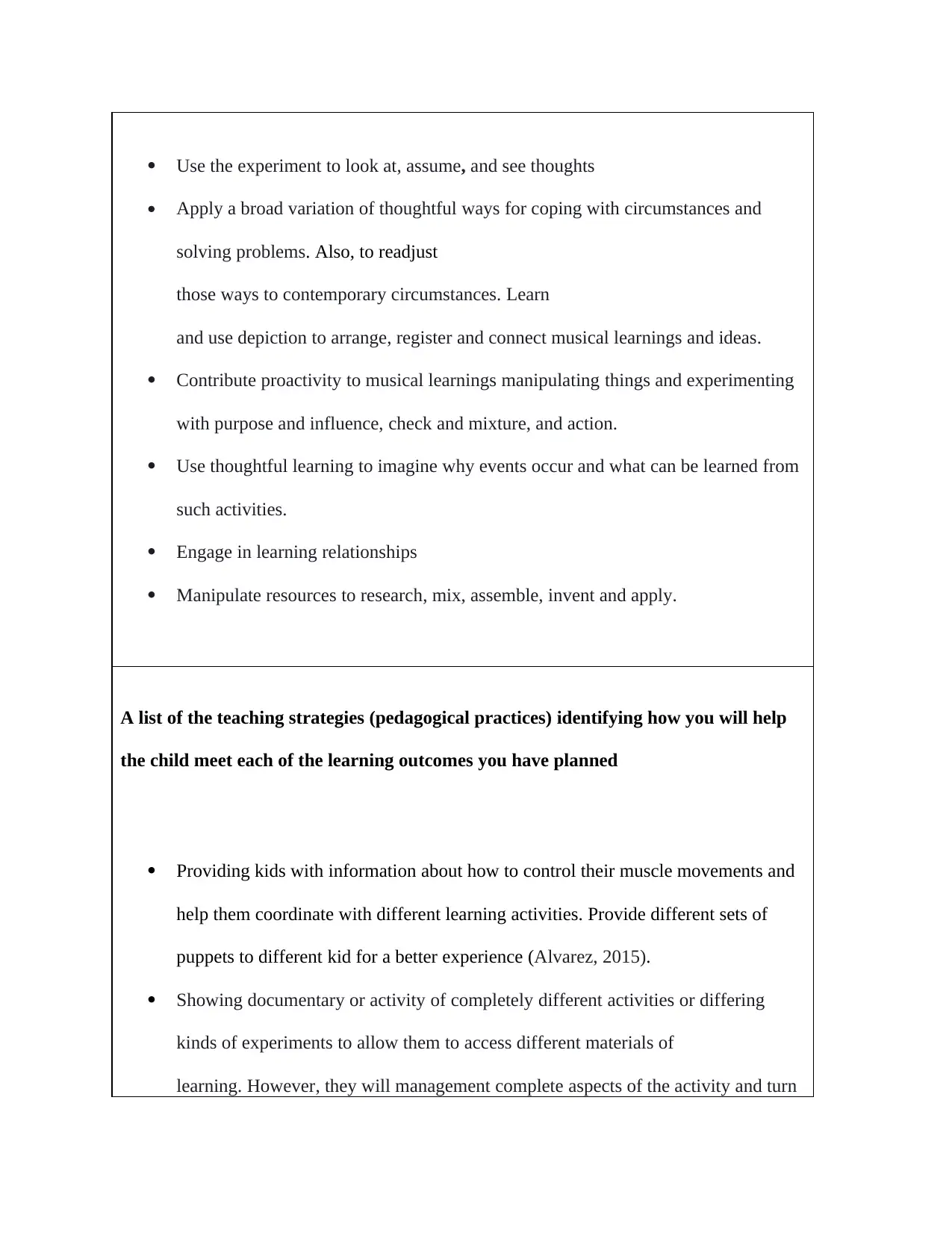
Use the experiment to look at, assume, and see thoughts
Apply a broad variation of thoughtful ways for coping with circumstances and
solving problems. Also, to readjust
those ways to contemporary circumstances. Learn
and use depiction to arrange, register and connect musical learnings and ideas.
Contribute proactivity to musical learnings manipulating things and experimenting
with purpose and influence, check and mixture, and action.
Use thoughtful learning to imagine why events occur and what can be learned from
such activities.
Engage in learning relationships
Manipulate resources to research, mix, assemble, invent and apply.
A list of the teaching strategies (pedagogical practices) identifying how you will help
the child meet each of the learning outcomes you have planned
Providing kids with information about how to control their muscle movements and
help them coordinate with different learning activities. Provide different sets of
puppets to different kid for a better experience (Alvarez, 2015).
Showing documentary or activity of completely different activities or differing
kinds of experiments to allow them to access different materials of
learning. However, they will management complete aspects of the activity and turn
Apply a broad variation of thoughtful ways for coping with circumstances and
solving problems. Also, to readjust
those ways to contemporary circumstances. Learn
and use depiction to arrange, register and connect musical learnings and ideas.
Contribute proactivity to musical learnings manipulating things and experimenting
with purpose and influence, check and mixture, and action.
Use thoughtful learning to imagine why events occur and what can be learned from
such activities.
Engage in learning relationships
Manipulate resources to research, mix, assemble, invent and apply.
A list of the teaching strategies (pedagogical practices) identifying how you will help
the child meet each of the learning outcomes you have planned
Providing kids with information about how to control their muscle movements and
help them coordinate with different learning activities. Provide different sets of
puppets to different kid for a better experience (Alvarez, 2015).
Showing documentary or activity of completely different activities or differing
kinds of experiments to allow them to access different materials of
learning. However, they will management complete aspects of the activity and turn
Paraphrase This Document
Need a fresh take? Get an instant paraphrase of this document with our AI Paraphraser
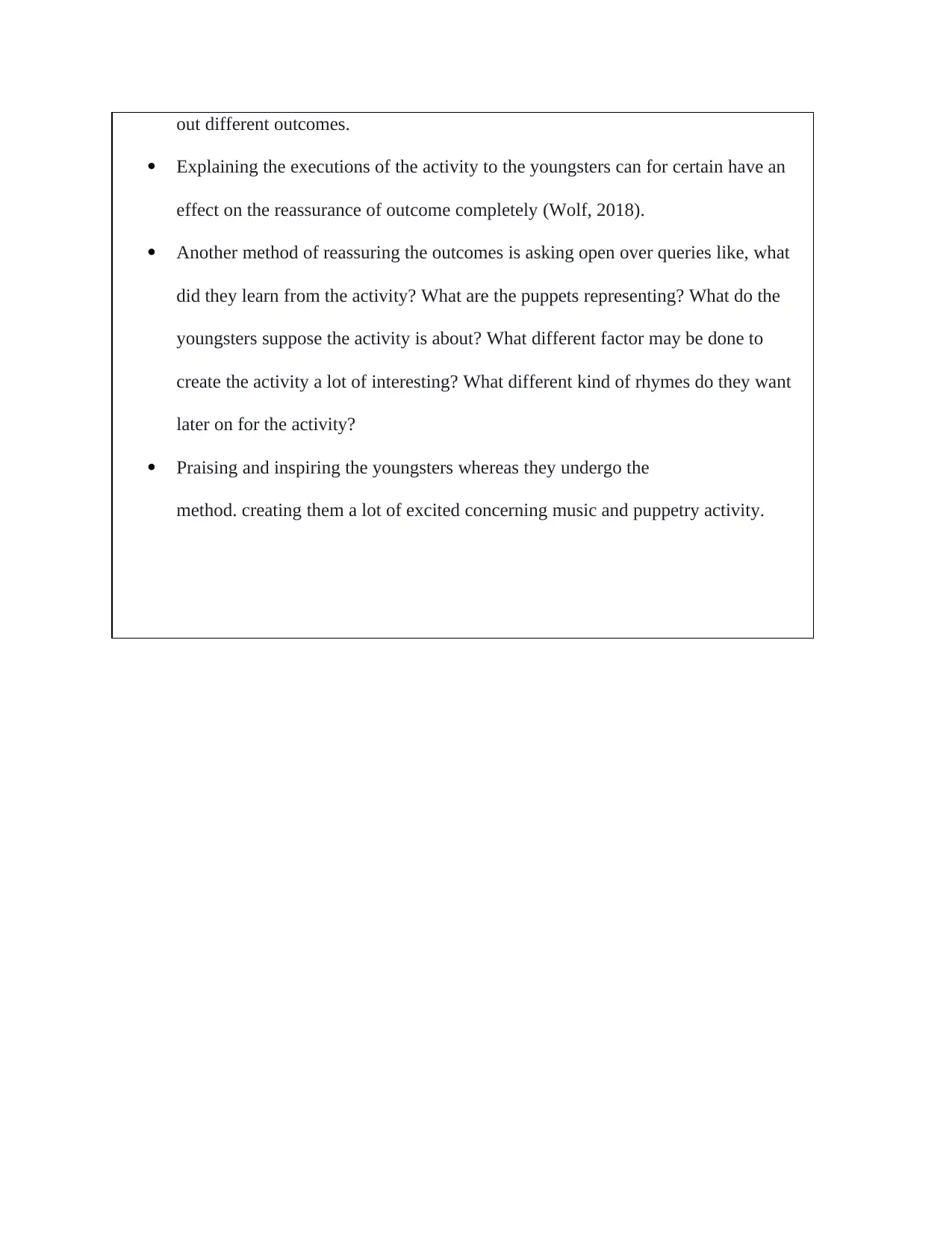
out different outcomes.
Explaining the executions of the activity to the youngsters can for certain have an
effect on the reassurance of outcome completely (Wolf, 2018).
Another method of reassuring the outcomes is asking open over queries like, what
did they learn from the activity? What are the puppets representing? What do the
youngsters suppose the activity is about? What different factor may be done to
create the activity a lot of interesting? What different kind of rhymes do they want
later on for the activity?
Praising and inspiring the youngsters whereas they undergo the
method. creating them a lot of excited concerning music and puppetry activity.
Explaining the executions of the activity to the youngsters can for certain have an
effect on the reassurance of outcome completely (Wolf, 2018).
Another method of reassuring the outcomes is asking open over queries like, what
did they learn from the activity? What are the puppets representing? What do the
youngsters suppose the activity is about? What different factor may be done to
create the activity a lot of interesting? What different kind of rhymes do they want
later on for the activity?
Praising and inspiring the youngsters whereas they undergo the
method. creating them a lot of excited concerning music and puppetry activity.
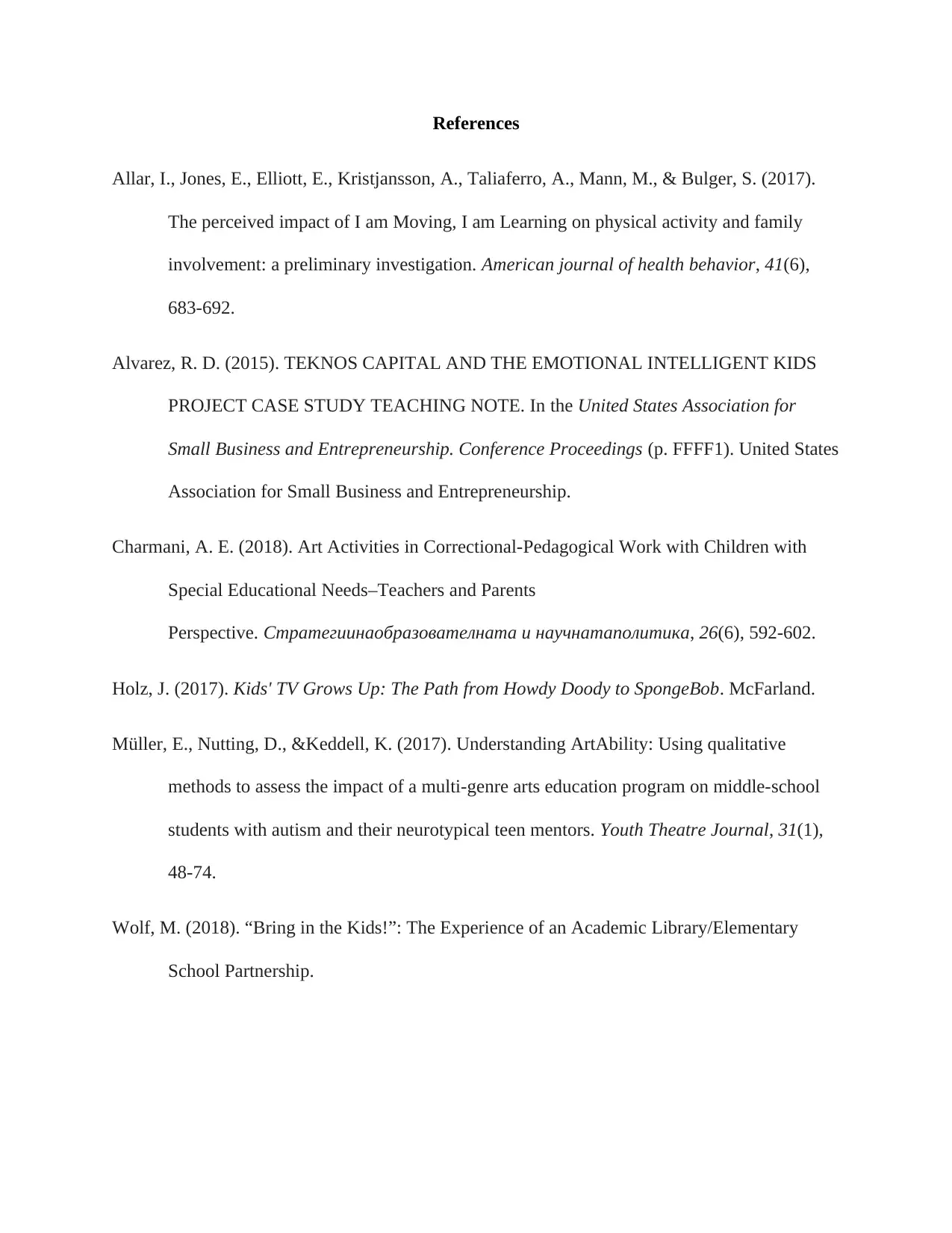
References
Allar, I., Jones, E., Elliott, E., Kristjansson, A., Taliaferro, A., Mann, M., & Bulger, S. (2017).
The perceived impact of I am Moving, I am Learning on physical activity and family
involvement: a preliminary investigation. American journal of health behavior, 41(6),
683-692.
Alvarez, R. D. (2015). TEKNOS CAPITAL AND THE EMOTIONAL INTELLIGENT KIDS
PROJECT CASE STUDY TEACHING NOTE. In the United States Association for
Small Business and Entrepreneurship. Conference Proceedings (p. FFFF1). United States
Association for Small Business and Entrepreneurship.
Charmani, A. E. (2018). Art Activities in Correctional-Pedagogical Work with Children with
Special Educational Needs–Teachers and Parents
Perspective. Стратегиинаобразователната и научнатаполитика, 26(6), 592-602.
Holz, J. (2017). Kids' TV Grows Up: The Path from Howdy Doody to SpongeBob. McFarland.
Müller, E., Nutting, D., &Keddell, K. (2017). Understanding ArtAbility: Using qualitative
methods to assess the impact of a multi-genre arts education program on middle-school
students with autism and their neurotypical teen mentors. Youth Theatre Journal, 31(1),
48-74.
Wolf, M. (2018). “Bring in the Kids!”: The Experience of an Academic Library/Elementary
School Partnership.
Allar, I., Jones, E., Elliott, E., Kristjansson, A., Taliaferro, A., Mann, M., & Bulger, S. (2017).
The perceived impact of I am Moving, I am Learning on physical activity and family
involvement: a preliminary investigation. American journal of health behavior, 41(6),
683-692.
Alvarez, R. D. (2015). TEKNOS CAPITAL AND THE EMOTIONAL INTELLIGENT KIDS
PROJECT CASE STUDY TEACHING NOTE. In the United States Association for
Small Business and Entrepreneurship. Conference Proceedings (p. FFFF1). United States
Association for Small Business and Entrepreneurship.
Charmani, A. E. (2018). Art Activities in Correctional-Pedagogical Work with Children with
Special Educational Needs–Teachers and Parents
Perspective. Стратегиинаобразователната и научнатаполитика, 26(6), 592-602.
Holz, J. (2017). Kids' TV Grows Up: The Path from Howdy Doody to SpongeBob. McFarland.
Müller, E., Nutting, D., &Keddell, K. (2017). Understanding ArtAbility: Using qualitative
methods to assess the impact of a multi-genre arts education program on middle-school
students with autism and their neurotypical teen mentors. Youth Theatre Journal, 31(1),
48-74.
Wolf, M. (2018). “Bring in the Kids!”: The Experience of an Academic Library/Elementary
School Partnership.
⊘ This is a preview!⊘
Do you want full access?
Subscribe today to unlock all pages.

Trusted by 1+ million students worldwide
1 out of 6
Related Documents
Your All-in-One AI-Powered Toolkit for Academic Success.
+13062052269
info@desklib.com
Available 24*7 on WhatsApp / Email
![[object Object]](/_next/static/media/star-bottom.7253800d.svg)
Unlock your academic potential
Copyright © 2020–2025 A2Z Services. All Rights Reserved. Developed and managed by ZUCOL.





